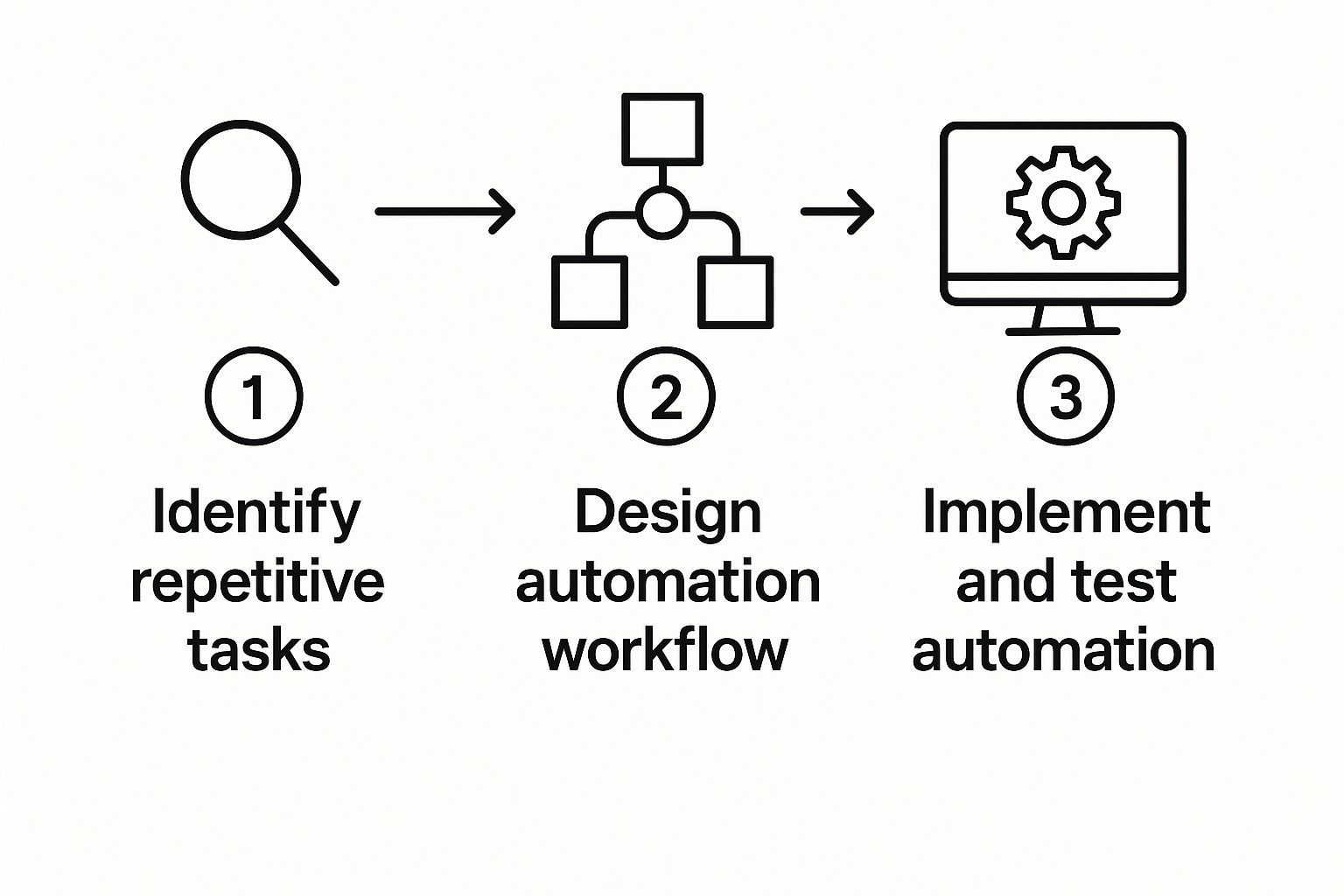Before you can really get a handle on automation, you have to get honest about the real, often hidden, price of sticking with manual work. Those little, recurring tasks aren't just minor irritations; they're silent killers of productivity, morale, and your bottom line.
What Manual Repetitive Work is Really Costing You
Think about it. The endless copy-pasting, the mind-numbing data entry, the routine report you could build in your sleep. These tasks feel like a drag because they are. They are low-value activities that eat up high-value time. When you have smart, skilled people bogged down in this kind of work, you're handcuffing their ability to think creatively and solve real problems.
This isn't just theory—it has a tangible impact. The constant drip of tedious tasks is a direct line to employee disengagement and burnout. People start to feel like their talents are being wasted, which tanks job satisfaction and leads to higher turnover. So, you end up paying twice: once for hours spent on inefficient work, and again for the staggering cost of replacing good people.
From Annoyance to Opportunity
The key is to start looking at these chores in a new light. Instead of seeing them as a necessary evil, see them for what they are: golden opportunities for improvement. The goal here isn't to replace your team; it's to elevate them. When you automate the grunt work, you give your people back their most precious asset—time.
This mental shift is powerful. It recasts automation from a threat into a tool for building a more engaging and productive workplace. The payoff goes way beyond just getting things done faster.
The real win from automation isn't just doing the same work faster. It's unlocking your team's potential to tackle bigger challenges, innovate on processes, and focus on the human-centric work that technology can't replicate.
The data from just about every industry confirms this. This isn't some niche trend; it's a fundamental change in how smart businesses are run. In fact, research shows that about 94% of companies are still doing repetitive, time-sucking tasks manually. But for those that have embraced automation, the results are clear. A whopping 90% of knowledge workers say it has made their jobs better, and 66% report a direct boost in their personal productivity. You can dig into more workflow automation statistics to see the full picture.
This massive shift is happening because automation helps people manage overwhelming workloads and dodge burnout. With the machines handling the monotony, your team is free to concentrate on what they were actually hired to do:
- Strategic Initiatives: Planning for the future instead of getting stuck in the weeds of daily admin.
- Creative Problem-Solving: Figuring out tough challenges that require human insight.
- Customer-Facing Interactions: Building real relationships with clients.
- Skill Development: Learning new things that bring more value to the company and their own careers.
At the end of the day, tackling manual work isn't just an IT project; it's a strategic move that directly impacts your efficiency, employee retention, and your ability to stay competitive.
Common Repetitive Tasks and Their Automation Solutions
To make this more concrete, I've seen firsthand how different departments get bogged down by similar types of repetitive work. The good news is that for nearly every tedious manual process, there's a smarter, automated way to get it done.
The table below breaks down some of the most common time-wasters I see across various departments and points to the kinds of solutions that can eliminate them for good.
Looking at this list, you can probably spot a few tasks that feel painfully familiar. These examples just scratch the surface, but they illustrate a powerful point: identifying the pain is the first step toward finding the cure. The right automation can turn these daily drains into seamless, background processes.
Pinpointing Your Best Automation Opportunities

Before you jump into automating anything, you first need to figure out where to start. It’s easy to think we know where our time goes, but the reality is often surprising. The best way I've found to get a clear picture is to move past guesswork and do a quick, focused "task audit." This is all about finding your biggest automation wins right out of the gate.
The sweet spot for automation is any task that’s both frequent and highly predictable. From what I’ve seen, the processes that work best are the ones that don't need creative thinking or nuanced judgment calls. They simply follow a clear set of rules, every single time.
Conducting Your Task Audit
Take a single week and just write down everything you do. The key here is to be brutally specific. Don't just write "manage field notes." Instead, break it down: "call three technicians for verbal updates," "listen to and transcribe two voicemails," and "manually type job details from my notebook into the project management system."
Once you have that list, run each task through a simple filter. A task is a great candidate for automation if it checks these boxes:
- It's High-Frequency: Does it happen every day? Multiple times a day? These are the little things that add up to a huge time sink.
- It's Rule-Based: Can you map it out as an "if this, then that" flow? If the steps are predictable and don't change, it’s a perfect candidate.
- It's Low-Creativity: Does this task require a human touch or strategic thought? If not, it’s just manual work a system could do faster and without errors.
A task audit isn't about finding what's wrong with your workflow. It's about finding freedom. Every repetitive chore you spot is a chance to get back time you can spend on work that actually matters.
If you need some inspiration, looking at some common key business process automation examples can really help you see the possibilities for your own operations.
Scoring and Prioritizing Your Tasks
You're probably going to end up with a pretty long list of things you could automate. So, how do you decide what to tackle first? I use a simple scoring system. It helps you focus on the automations that will give you the biggest return for your effort, and fast.
For each task on your list, give it a score from 1 (low) to 5 (high) based on these questions:
Add up the scores. The tasks with the highest totals should be at the very top of your list. If you find a task that’s time-consuming, easy to mess up, and that everyone on the team hates doing, you've found your perfect starting point. This structured approach ensures you focus on automating the work that will provide the most immediate and welcome relief.
Finding the Right Automation Toolkit for Your Needs

Okay, so you've pinpointed the routine chores that are eating up your team's time. Now for the fun part: picking the right tool to take over. The market is absolutely flooded with options, from massive industrial systems to slick software, and it's easy to get lost.
The secret is to match the tool to the specific job you need to automate repetitive tasks, not the other way around.
Your choice really hinges on your work environment and what you're trying to accomplish. A marketing team working out of an office has entirely different needs than a crew of technicians out in the field. One group might be trying to automate social media posts, while the other needs a way to log job notes from a loud, messy work site. The context is everything.
Differentiating Automation Platforms
Let's break down the world of automation tools into a few main camps. Getting a handle on these categories will help you cut through the noise and find something that actually solves your team's problems. Forget the brand names for a minute and just focus on the type of tool that fits your work.
No-Code/Low-Code Platforms: These are probably the most accessible tools out there, built for people who aren't developers. Think of platforms like Zapier or Microsoft Power Automate. They let you connect different apps using a simple visual interface. They’re fantastic for office workflows, like automatically creating a Trello card from a new Gmail message.
Industrial Automation Systems: At the complete opposite end are the heavy-duty systems you’d find in manufacturing. Programmable Logic Controllers (PLCs) are the bedrock of this world, running the precise, repetitive programs that control factory equipment. They are workhorses for physical processes, but as you can read in this paper on how industrial automation has evolved, adapting them to modern, digital-first workflows can be a real challenge.
Dedicated & Purpose-Built Solutions: This is my favorite category because these tools are designed to do one thing exceptionally well. You see this with social media schedulers, and you see it with tools like Nora for field service. These solutions are built from the ground up to understand the specific context of a job—like taking a technician's garbled voice note from their truck and turning it into a perfectly formatted report.
Choosing the Right Tool for the Job
So, how do you pick one? I’ve found the best way is to work backward from the problem itself. Don't start by scrolling through software websites. Start by nailing down the exact, mind-numbing task you want to get rid of.
Let me give you a real-world example. I worked with an operations manager at a plumbing company who was tearing her hair out. Her team was losing hours every single day just chasing down technicians for job notes. The techs, understandably, hated stopping what they were doing to type on their phones, and the office staff was stuck trying to decipher messy, incomplete updates.
A no-code tool like Zapier could connect a form to a spreadsheet, but that wouldn't fix the root problem. The technicians still wouldn't want to mess with a clunky interface in the field. The best solution had to fit into their existing habits.
This is exactly where a purpose-built tool shines. A solution that lets the field team send voice notes, photos, and quick texts through a familiar app like WhatsApp completely removes that friction. It meets them where they already are, which makes getting them on board practically effortless.
Your goal should always be to find the path of least resistance for your team. That's how you get results.
Alright, let's move past the theory and get our hands dirty. This is where the magic really happens—when you see a clunky, manual process transform into a smooth, automated one right before your eyes. We're going to build a practical workflow from the ground up.
Our focus will be on a classic headache for any business with teams in the field: automating routine field reporting.
Imagine a field technician finishes a job. Instead of juggling apps or scribbling notes to type up later, they just send a quick update. That single action will set off a chain reaction, handling all the data entry and follow-ups automatically. No coding, no complicated software—just a smart, simple flow.
This visual breaks down how you can turn a manual chore into a fully automated system. It’s not just one step, but a structured process of identifying the problem, designing the solution, and putting it into action.

Defining Your Trigger and Actions
Every automated workflow needs a starting pistol. We call this the trigger—it’s the specific event that kicks everything off. Everything that follows is an action.
Let's map out our field reporting scenario. It's a common one I've seen countless times.
The Trigger: A technician sends a message to a dedicated WhatsApp number. The message contains a quick voice note explaining the work done, a photo of the completed job, and the job number. This is something they can do in 30 seconds from their truck without opening a clunky app.
Action 1: An AI assistant like Nora immediately gets to work. It transcribes the voice note into clean text and neatly packages it with the photo and job number.
Action 2: The newly formatted note is automatically saved into the correct project folder in your company's Google Drive or Dropbox. No more dragging and dropping files.
Action 3: A notification instantly pops up in the project manager’s Slack channel, complete with the key details and a direct link to the full note.
Action 4: At the same time, a new row is added to a master Google Sheet. This log tracks the technician's name, the job number, a timestamp, and a summary of the update, creating a perfect audit trail.
Just like that, we've connected four different systems and eliminated at least four manual steps. The technician saves time, the manager gets real-time updates, and the data is logged perfectly without anyone having to do a thing.
Connecting Your Favorite Apps
The secret sauce behind this is connecting the software your team already relies on. Modern no-code platforms provide a visual canvas where you can link your apps together. Think of it like building with digital LEGOs.
These platforms, like Zapier, have massive marketplaces of apps ready to connect.

The sheer number of available integrations means that almost any digital tool your team uses—from email clients to project management boards—can be woven into an automated workflow.
If there's one piece of advice I can give you, it's this: start with the tools your team actually uses every single day. Don't force a new app on them just for the sake of automation. That's a classic recipe for failure. The best automations meet people where they already are.
Using WhatsApp as the trigger in our example is a game-changer because technicians live on it. There’s no new app to download, no new interface to learn. By following the path of least resistance, you guarantee your team will actually use it.
This approach ensures high adoption from day one and immediately begins to automate repetitive tasks that cause the most friction. You’re not just automating for the sake of it; you’re solving a real-world problem and making everyone’s job just a little bit easier.
Tracking Your Wins and Dodging Common Roadblocks

Getting your first automated workflow live is a great feeling, but that’s just the starting line. The real magic happens afterward, when you start to consistently track your results and learn to sidestep the common traps that can sink even the best-laid plans. It's not about just flipping a switch; it's about proving that the switch is actually powering real, tangible improvements.
You have to get beyond just a gut feeling that things are "more efficient." It’s time to dig into specific metrics. This isn't about creating more work for yourself; it's about building a rock-solid case for the value you're creating. These numbers will be your proof.
What to Measure: The KPIs That Actually Matter
Think back to the initial task audit you performed. The biggest headaches you identified then are exactly what your metrics should be tracking now.
Hours Saved Per Week: This is the big one. How long did a task take before? How long does it take now (often, it's zero)? Do the math. That number represents pure, reclaimed time that your team can now invest in work that truly matters.
Error Rate Reduction: We all know manual data entry is a minefield for typos and mistakes. Start tracking the number of errors—wrong job numbers, misspelled client names, you name it—before and after you brought in automation. Watching a 5% error rate plummet to nearly zero is a huge win for your data's integrity.
Task Completion Speed: Before, how long did it take for a field report to get from a technician’s clipboard into your system? Days? Now, it’s probably seconds. That acceleration has a ripple effect, speeding up everything from invoicing to project kick-offs.
Plenty of companies are jumping into automation, but success isn't a given. While businesses investing in automation see an average 22% cut in operating costs, a sobering 70% of digital transformation projects don't actually hit their goals. That gap tells a crucial story: just buying the software is not the answer. If you want to dig deeper, you can see how strategy is key to automation ROI.
Sidestepping the Usual Automation Pitfalls
Knowing what can go wrong is just as important as tracking what’s going right. Over the years, I’ve seen enthusiastic teams get tripped up by the same few issues time and time again. Let's make sure that doesn't happen to you.
The most common mistake I see is automating a broken process. If your manual workflow is confusing or inefficient, automating it just helps you do the wrong things faster. Always fix the process first, then automate the fixed version.
Another classic blunder is forgetting about the people involved. Don’t just drop a new system on your team and expect them to embrace it. You have to explain the why. Show them how this change makes their jobs less tedious and more impactful. Once they see what’s in it for them, they’ll become your biggest champions.
Frequently Asked Questions About Task Automation
Whenever I talk about automation, the same great questions pop up. It’s only natural to wonder about the real-world impact—things like cost, complexity, and especially how it might change your day-to-day job. Let's get right into the most common ones so you can feel confident about how you automate repetitive tasks.
Will Automating Tasks Make My Job Obsolete?
This is easily the biggest worry I hear, and it’s completely understandable. The truth, however, isn't about eliminating jobs, but about evolving them. Automation is a powerhouse for handling the predictable, rules-based stuff—frankly, the boring work that drains your energy.
By handing off those monotonous tasks, you get to double down on what people are irreplaceable for: creative problem-solving, strategic planning, and building genuine client relationships. So, think of it less as a replacement and more like a super-efficient assistant that takes care of the grunt work. This frees you up for the high-impact projects that truly need your expertise and a human touch.
Do I Need Coding Skills to Automate My Work?
Not at all. This is the best part. Thanks to a new generation of no-code and low-code platforms, anyone can build powerful automations.
At its heart, automation follows a simple "If this happens, then do that" logic. If you can map out that simple sequence in your head, you already have the most important skill.
Today's tools use visual, drag-and-drop builders that let you connect your favorite apps—your email, CRM, project management tool, you name it—without touching a single line of code. It’s all about understanding your own workflow, not about learning Python.
How Much Does It Cost to Start Automating?
You can actually start for free. Seriously. Most of the leading automation tools like Zapier and Make have fantastic free plans that are more than enough for individuals or small teams to get their feet wet. It’s a zero-risk way to see the benefits for yourself.
Once your automations become more critical or complex, you might look at a paid plan. These usually start in the $20-$50 per month range. When you consider the hours you’ll save each week and the reduction in costly manual errors, the return on that small investment is almost immediate and incredibly high.
Ready to eliminate manual note-taking and give your field team back valuable time? Discover how Nora uses AI and WhatsApp to automate your entire field reporting process. Learn more and get started with Nora today.



